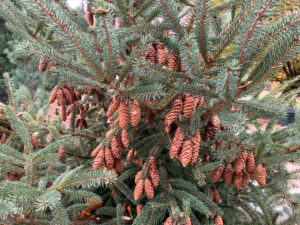Why So Many Cones?
December 14th, 2021
Have you noticed the huge amount of cones this year on so many of our needled evergreen trees?

Heavy cone sets like this one are common this year on spruce.
Spruce trees in particular seem to be loaded with them.
What gives?
While hefty cone production isn’t a predictor of what kind of winter we’re about to have (as some think), it can be a side effect of weather past.
Hot and especially dry summers put extra stress on trees, which can influence how many seeds the trees produce the following year.
More stress generally means more seeds as trees “decide” they ought to ramp up production when germination and survival conditions aren’t favorable.
Species that prefer cool climates, such as most spruces and firs, are particularly prone to hot-weather and drought stress.
Since cones are the protective housing for seeds in cone-bearing species (“conifers”), that could partly explain why we’re seeing more cones than usual this year. You’ll remember that we had a very hot and dry spell for a few weeks in the middle of last summer.
Besides that, though, most conifers produce heavy cone sets in two-year cycles.
They’ll naturally produce a lot of cones one year and then produce few the next year – almost as if they’re taking a year to rest after doing such a good reproductive job the year before.
Many fruit and nut trees do the same thing with their production of fruits, acorns, and nuts.
So don’t be surprised that after this coneful year, you see a sparse showing next year.
Unless you’re a Christmas tree grower, this year’s large number of cones isn’t a problem for conifers, and it’s not a sign that the trees are dying or otherwise in trouble.
If you are a Christmas tree grower, cones can slow growth and cause some gaps where they monopolize space that otherwise would be occupied by growing stems. That works against the goal of maximum growth and perfect shape.
Lots of cones will make the squirrels happy, though, since cones are a favorite snack.
For us, it’ll mean a lot more raking them off the lawn since too many can smother grass and cause bare spots.
In that case (or if you just don’t like the look of dropped cones), they can be composted or smashed and used as mulch. They also burn well if you have an outdoor fire pit.
Cones can be left in garden and landscaped beds, where they’ll mulch in place.
They’re a bit slow to break down, but they eventually return organic matter to the soil and slightly acidify, making them a good choice for mulching around acid-loving plants like blueberries, hollies, azaleas, rhododendrons, and dogwoods.







